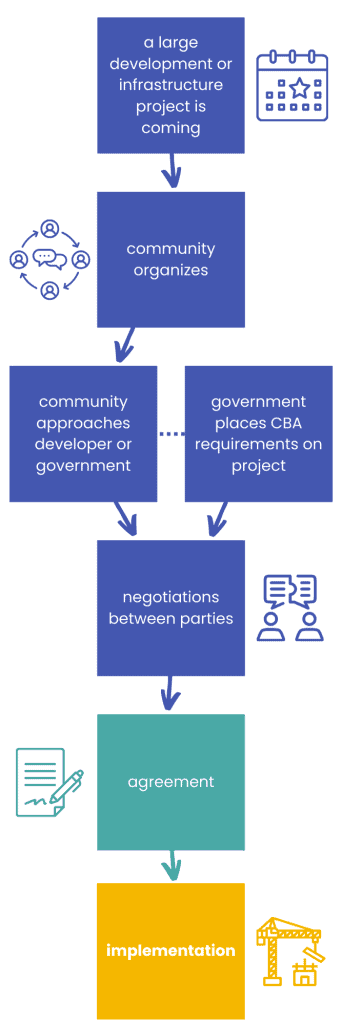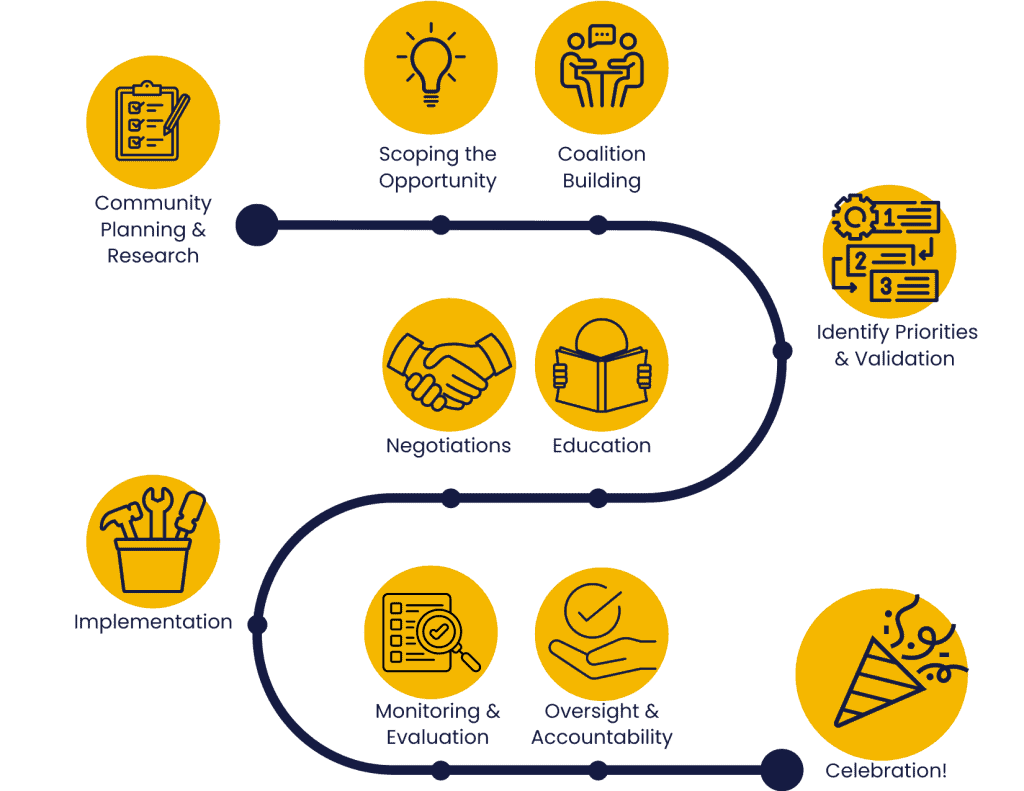What is a Community Benefits Agreement?
The “Benefits” in Community Benefits Agreement (CBA) is a broad term that can cover a number of different categories, but the “Agreement” part is more specific. One of the leading legal authorities on CBAs offers this succinct definition:
A CBA is a legally binding contract (or set of related contracts), setting forth a range of community benefits regarding a development project, and resulting from substantial community involvement.
– Julian Gross, “Community Benefits Agreements: Definitions, Values, and Legal Enforceability,” 2008. https://juliangross.net/wp-content/uploads/2024/09/CBA_Definitions_Values_Enforceability.pdf
Canadian anthropologist Andrew Galley expands on this definition:
Community Benefits Agreements (CBAs) are a strategic tool used in the process of building community wealth. CBAs are negotiated agreements between a private or public development agent and a coalition of community-based groups. This coalition may include neighbourhood representatives, single-issue advocates, labour unions, social service agencies, religious congregations, faith-based groups and others. Together, they give a voice to people in infrastructure planning and land development processes – especially those individuals who have been historically excluded or marginalized from these processes and decisions that affect them.
– “Community Benefit Agreements” 2015. https://communitybenefitsagreements.ca/
The Community Benefits movement originated in the US about 25 years ago, with the Staples Centre in Los Angeles as the first major example of the concept in 2001. Jovanna Rosen, in her 2023 study, Community Benefits: Developers, Negotiations, and Accountability, outlines the history of the movement:
In the late 1990s and early 2000s, community advocates began to use their selective support for development projects, rather than resistance, to compel developers, labor unions, and local governments to meet at the negotiating table. Within a history of community exclusion and harm from urban development, community activists posed a simple but critically important question: Who would benefit from future local development? Communities sought to create tools to improve equity in the development process.
The Process of Arriving at a CBA
When a large development or infrastructure project is coming to a neighbourhood, it may be identified by a Community Benefits organization as a good candidate for a CBA, for instance because of its potential to disrupt residents’ lives or concern that they would not otherwise benefit economically from the development. At this point, the community needs to organize to be in a position to ask for a CBA. This type of agreement requires grassroots action and significant community involvement.
The type of project determines the approach community leaders need to employ. In the case of a private development, a community coalition will usually need the support of local government, who are able to grant or withhold planning permission, but will also need to approach the developers, who must ultimately sign on to the CBA. With a public infrastructure project, for instance a bridge or a transit line, the community deals with whichever level of government is responsible for the work.

Once an agreement is reached detailing the benefits the community can expect from the project, the work of implementation begins. Large construction projects take years, and there may be many changes in personnel involved. A successful CBA requires careful oversight to ensure that terms are met and the priorities identified by the community remain in view throughout the process.
The following graphic (following the work of Kumsa Baker from the Toronto Community Benefits Network) breaks down in more detail the process from the perspective of community organizers:

What Can Be Done with a CBA?
Here’s where we address the expansive “Benefits” part of the definition. Karl Andrus from Hamilton Community Benefits Network has helpfully broken these down into eight categories.
Housing

Particularly applicable to residential developments, a CBA can include provision for a certain number of deeply affordable units or other measures to address the housing shortage.
Social Benefits

A CBA can provide resources to address a variety of social concerns and priorities of the community.
Community Funds

A CBA could be used to establish a fund from which the community can draw for future projects that reflect their goals and values.
Environmental Benefits

A CBA can aim to offset some of the environmental impact of a development through targeted projects.
Neighbourhood Improvements

Neighbours affected by construction, gentrification, and other aspects of development can negotiate for direct benefits in the form of spending on projects to improve their homes and streetscapes.
Social Procurement

Procurement refers to the purchasing that a developer or a government does in the course of a project. Social procurement means thoughtfully targeting that spending to help marginalized groups and support businesses that are actively improving the community. Instead of asking only “How can we get this item for the lowest cost?” it means considering, “Who can benefit from this money? Which business do we want to support?”
Local Business Support

Like Social Procurement, this is about using the purchasing power of developers to benefit the community, in this case by requiring that money be spent at local businesses.
Community Employment Benefits

Employment Benefits are a crucial aspect of CBAs, requiring developers to hire local labour, provide apprenticeships and training opportunities for tradespeople, and consider the needs of underrepresented groups in their hiring practices.
